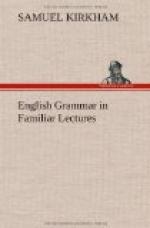Now let us clearly understand this 4th Rule. Recollect, it applies to the verb and not to the noun; therefore, in these examples the verb is ungrammatical. The noun boys, in the first sentence, is of the third person plural, and the verb improves is of the third person singular; therefore, Rule 4th is violated, because the verb dues not agree with its nominative in number. It should be, “boys improve.” The verb would then be plural, and agree with its nominative according to the Rule. In the fourth sentence, the verb does not agree in person with its nominative. Thou is of the second person, and shuns is of the third. It should be, “thou shunnest,” &c. You may correct the other sentences, and, likewise, the following exercises in
FALSE SYNTAX.
A variety of pleasing objects charm the eye. The number of inhabitants of the United States exceed nine millions. Nothing but vain and foolish pursuits delight some persons.
In vain our flocks and fields increase
our store,
When our abundance make us wish for more.
While ever and anon, there falls
Huge heaps of hoary, moulder’d walls.
LECTURE III.
OF ARTICLES.
An article is a word prefixed to nouns to limit their signification; as, a man, the woman.
There are only two articles, a or an, and the. A or an is called the indefinite article. The is called the definite article.
The indefinite article limits the noun to one of a kind, but to no particular one; as, a house.
The definite article generally limits the noun to a particular object, or collection of objects; as, the house, the men.
The small claims of the article to a separate rank as a distinct part of speech, ought not to be admitted in a scientific classification of words. A and the, this and that, ten, few, and fourth, and many other words, are used to restrict, vary, or define the signification of the nouns to which they are joined. They might, therefore, with propriety, be ranked under the general head of Restrictives, Indexes, or Defining Adjectives. But, as there is a marked distinction in their particular meaning and application, each class requires a separate explanation. Hence, no practical advantage would be gained, by rejecting their established classification, as articles, numerals, and demonstratives, and by giving them new names. The character and application of a and the can be learned as soon when they are styled articles, as when they are denominated specifying or defining adjectives.
The history of this part of speech is very brief. As there are but two articles, a or an and the, you will know them wherever they occur.




